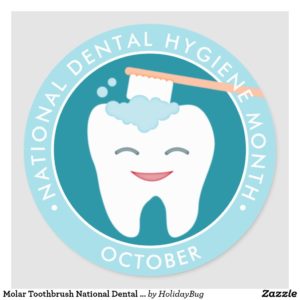During the month of February, the American Dental Association celebrates National Children’s Dental Health Month.
National Children’s Dental Health Month, with the 2022 theme being “Sealants Make Sense.”
The month is a national health observance that brings together thousands of dedicated professionals, health care providers and educators to promote the benefits of good oral health to children, their caregivers, teachers and many others.
Irene Hilton, D.D.S., chair of the ADA Council on Advocacy for Access and Prevention’s advisory committee on dental sealants, said sealants are an equitable way to prevent caries.
“Sealants on permanent molars reduce the risk of caries by 80%,” Dr. Hilton said. “If your dentist recommends dental sealants, it is part of a comprehensive caries management approach. I am excited that this year” National Children” Dental Health Month theme is about dental sealants, so more families are aware of this cavity-preventing treatment.”
New parents often ask, “When should my child first see a dentist?” It’s never too early to start focusing on your child’s oral health! The American Association of Pediatric Dentists recommends that parents establish a dental home for their child by their first tooth or first birthday. During this time, parents/guardians will have the opportunity to ask questions and address any dental concerns at the primary visit and the dentist will gently swab the child’s mouth to check their gums and any erupted teeth. As the child starts teething, the dentist will be able to monitor their progress and implement preventative measures for any concerns with your baby’s teeth.
Protect Tiny Teeth
Baby teeth are so important because of their key role of saving space for a child’s permanent teeth. They stay in a child’s mouth for 8-10 years and also affect their speaking, chewing, and, of course, smiling. Baby teeth can also indicate a child’s overall quality of health. Untreated tooth decay can cause oral infections that enter the bloodstream and lead to other serious health problems, while also allowing bacteria to spread to new adult teeth.
While daily brushing is an important part of a child’s oral hygiene routine, bacteria that causes tooth decay can still linger between teeth where the toothbrush can’t reach. That’s why it’s so important to help your kids incorporate flossing in their daily routine.
One significant oral health risk for infants and young children under the age of 1 is from baby bottle tooth decay. This occurs when your child consumes sugary liquid and bacteria in their mouth consume the sugar and produce acid. This acid attacks the enamel on baby teeth can trigger tooth decay after continued exposure. Liquids that contribute to this condition include milk, formula, fruit juice, soda, and any other sweetened drinks. If your child needs to sleep with a bottle, water is the safest option without any risk.
Parents, Did You Know?
Early childhood tooth decay has become the most common chronic childhood disease, impacting more children than asthma. According to the ADA, more than 40% of children have tooth decay by the time they reach Kindergarten. Additionally, kids who suffer from poor oral health are three times more likely to miss school as a result of dental pain.
The State of Pennsylvania has tried to tackle this oral health epidemic by requiring each child to receive a dental examination before enrolling in school, as well as in the 3rd and 7th grades. However, without regular six-month check-ups and establishing healthy oral health habits at an early age, small cavities can lead to much larger problems in little mouths.
Tips for Maintaining Your Child’s Oral Health
Our doctors take pride in serving patients in such vital years of early childhood. As pediatric dentists, they’ve had additional training beyond dental school to work specifically with babies and children in monitoring early oral development. We recommend the following oral health tips to start your little ones on their journey to a lifetime of healthy smiles.
- Schedule routine check-ups. If it’s been more than six months since your child has seen a dentist, schedule an appointment as soon as possible.
- Clean your baby’s gums daily. Until those teeth come in gently wipe a damp washcloth over the gums to clear away harmful bacteria after each feeding.
- Start brushing with the first tooth. Begin brushing your baby’s teeth when you see one coming in with an infant toothbrush. Use water and a tiny bit of fluoride toothpaste (about the size of a grain of rice).
- Brush twice each day for two minutes. Children ages 2-6 should use a pea-sized amount of fluoride toothpaste. Always supervise kids younger than six years old while brushing, as they are more likely to swallow toothpaste.
- Begin flossing. Once your child’s teeth touch, you can start flossing in between them.
- Snack healthy! Fruit juice, sports drinks, fruit snacks, and sticky candies all pose serious threats to your child’s teeth. Give kids calcium-rich snacks like cheese or low-sugar yogurt. If you have to resort to candy – a chocolate bar is preferable to gummy or sticky sweets that can get lodged in between the teeth, even after brushing.
- Keep them hydrated! Avoid sugary drinks and stick to good old-fashioned water. Water helps to rinse away any sugar or particles that can lead to cavities. Many municipal water sources also contain fluoride, which is recommended by the American Dental Association and U.S. Surgeons General, among others, as an efficient way to prevent tooth decay. In fact, the theme of this year’s National Children’s Dental Health Month is celebrating 75 years of water fluoridation.
- Replace your child’s toothbrush every three to four months.
